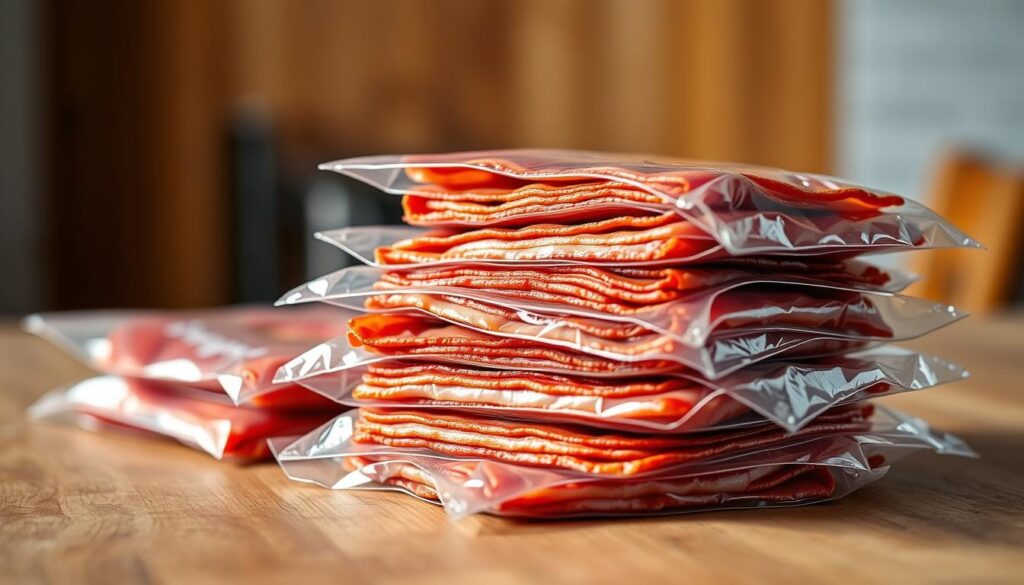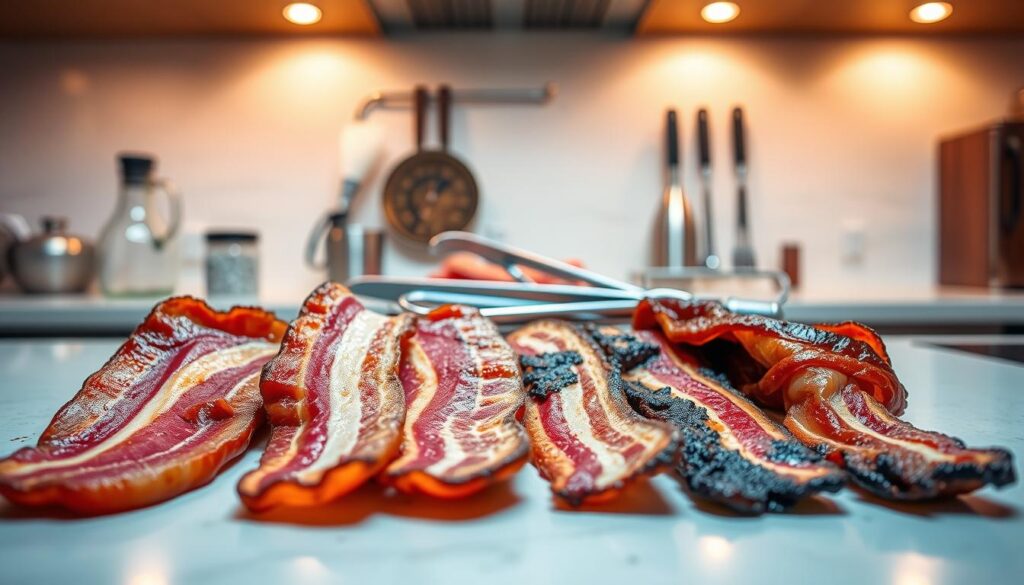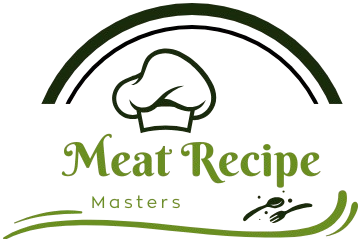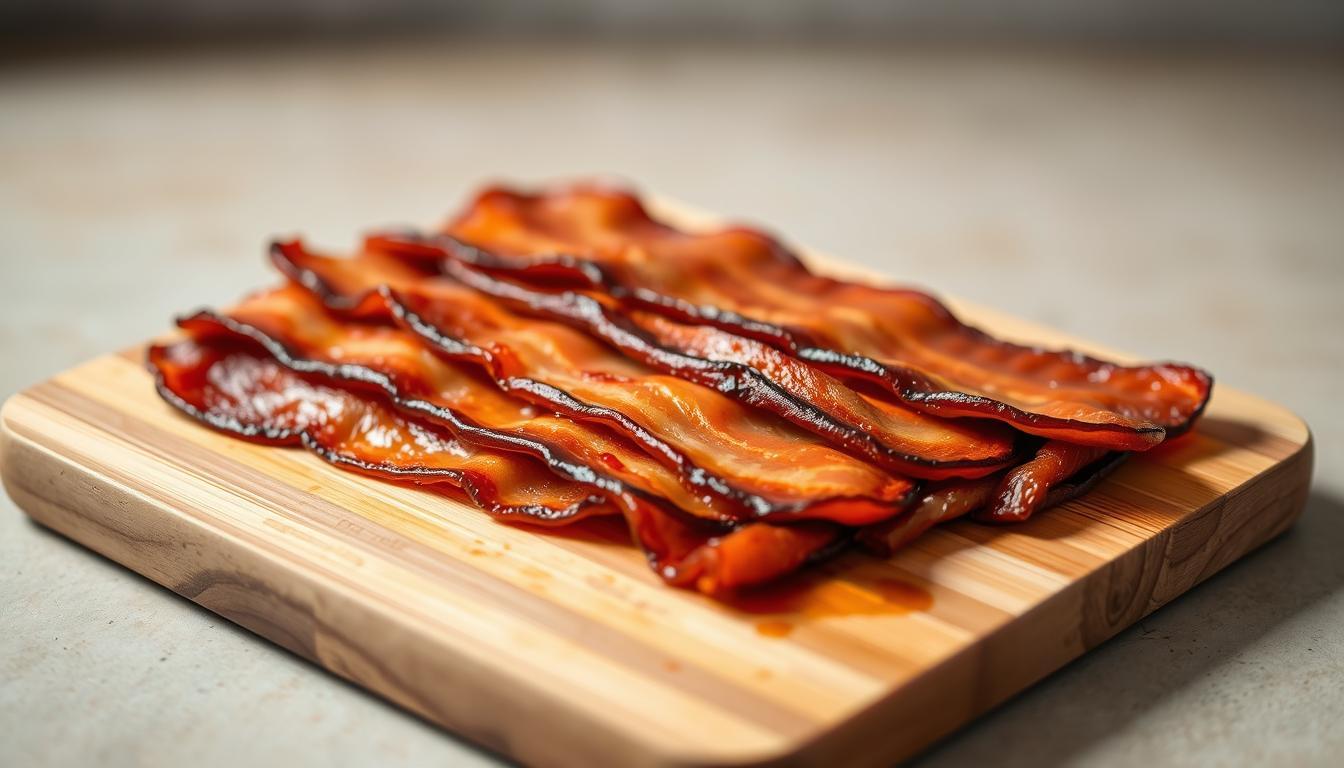How to Cook Beef Bacon: Easy Guide
The sizzle of beef bacon in the kitchen brings back memories of weekend breakfasts with my family. We always loved trying different proteins, and beef bacon was a favorite. If you’re curious about cooking beef bacon, you’re in the right place.
Beef bacon has a unique taste that’s different from traditional bacon. It’s made from the cow’s belly, brisket, or round. This protein is cured and smoked to perfection. Learning to cook beef bacon strips takes some technique, but it’s worth it for the delicious results.
This guide will teach you everything about preparing beef bacon. You’ll learn about its unique characteristics and how to cook it perfectly. By the end, you’ll be able to make savory beef bacon strips that impress everyone.
Table of Contents
Understanding Beef Bacon: A Flavorful Alternative
Beef bacon is a tasty choice for those who love meat and want to try something new. It’s different from regular pork bacon because of its unique taste and health benefits. This makes it a great choice for breakfast and cooking.
Beef bacon has some big differences compared to pork bacon. It’s made from special cuts of beef. This turns traditional butchering into a tasty breakfast favorite.
What Makes Beef Bacon Unique
Beef bacon stands out for several reasons:
- It has a richer, more complex flavor
- It has more protein than pork bacon
- It’s a good option for those looking for halal bacon
- It has a firmer meat texture
Types of Beef Cuts Used for Bacon
Butchers pick certain cuts of beef to make top-notch bacon. The most common cuts are:
- Beef belly
- Brisket
- Beef round
Nutritional Benefits of Beef Bacon
Beef bacon is good for those who care about their health. It’s a leaner protein option. This makes it a great choice for those looking for halal bacon alternatives.
| Nutrient | Beef Bacon | Pork Bacon |
|---|---|---|
| Protein per serving | 12g | 9g |
| Fat content | Lower | Higher |
| Flavor intensity | Rich | Standard |
Beef bacon is a tasty and flexible choice for anyone looking to try something new. It changes the way we think about breakfast.
Essential Tools and Equipment for Cooking Beef Bacon
To cook beef bacon strips, you need specific kitchen tools. These tools make sure your cooking is both delicious and safe. Having the right equipment is key to the cooking time.
- Heavy-duty baking sheet
- Parchment paper or aluminum foil
- Tongs for safe handling
- Meat thermometer
- Cast-iron skillet
- Splatter screen
A baking sheet lined with parchment paper is essential for oven cooking. Parchment paper prevents sticking and makes cleaning up a breeze. A meat thermometer is vital to ensure the beef bacon reaches the right temperature.
| Tool | Purpose | Recommended For |
|---|---|---|
| Cast-iron skillet | Even heat distribution | Stovetop cooking |
| Splatter screen | Reduce kitchen mess | Pan-frying methods |
| Meat thermometer | Check internal temperature | Safe cooking |
Investing in these tools will help you master beef bacon preparation. You’ll get consistent, delicious results every time you cook.
How to Cook Beef Bacon: Three Proven Methods
Cooking beef bacon needs skill and the right technique. Whether you’re cooking at home or are a food lover, learning different methods is key. Let’s look at three reliable ways to cook beef bacon that will make your dishes better.
Each method brings out special flavors and textures in beef bacon. Your choice depends on what kitchen tools you have, how much time you have, and what you like best.
Oven-Baked Method for Perfect Beef Bacon
Cooking beef bacon in the oven is easy and gives great results. Here’s how to do it:
- Preheat oven to 400°F (200°C)
- Line a baking sheet with parchment paper
- Arrange beef bacon slices in a single layer
- Bake for 15-20 minutes until desired crispiness
- Drain on paper towels to remove excess fat
Stovetop Pan-Frying Technique
The stovetop method is great for those who enjoy cooking by hand. Here’s how to get crispy bacon:
- Use a cold cast-iron skillet or non-stick pan
- Start with low to medium heat
- Place beef bacon slices without overcrowding
- Flip every 2-3 minutes for even cooking
- Cook until golden brown and crisp
Broiling for Caramelized Beef Bacon
Broiling is a quick way to get caramelized and crispy beef bacon. Here are some tips:
- Position oven rack 6 inches from broiler
- Line baking sheet with aluminum foil
- Arrange beef bacon in single layer
- Broil for 3-4 minutes per side
- Watch carefully to prevent burning
Pro tip: Always pat beef bacon dry before cooking. This helps it get extra crispy.
Perfect Oven Temperature and Timing Guide
Cooking beef bacon in the oven needs precision for that perfect crispy texture. The right temperature and timing are key to a great dish.
Beef bacon strips cook in 15-25 minutes. The exact time depends on the bacon’s thickness and how crispy you want it.
- Thin-cut beef bacon strips: 15-18 minutes
- Medium-cut beef bacon strips: 18-22 minutes
- Thick-cut beef bacon strips: 22-25 minutes
The best oven temperatures for beef bacon are 375°F to 425°F. Lower temperatures make the bacon softer. Higher temperatures make it crisper.
| Bacon Thickness | Oven Temperature | Cooking Time | Texture Result |
|---|---|---|---|
| Thin-cut | 400°F | 15-18 minutes | Crisp edges, tender center |
| Medium-cut | 375°F | 18-22 minutes | Balanced crispness |
| Thick-cut | 425°F | 22-25 minutes | Extra crispy |
Pro tip: Use a rimmed baking sheet with parchment paper or a wire rack for even cooking and easy cleanup. Rotate the baking sheet halfway through for even browning.
Remember, every oven is slightly different. Start checking your beef bacon around the 15-minute mark to prevent overcooking.
Pan-Frying Tips for Crispy Results
Mastering the stovetop beef bacon method takes skill and technique. Pan frying beef bacon can turn a simple meal into a feast. The secret is knowing how to get crispy bacon every time.
Choosing the right cookware is key for pan frying success. The right tools will help you get that perfect golden, crispy texture everyone loves.
Choosing the Right Pan
- Cast-iron skillet for even heat distribution
- Heavy-bottomed stainless steel pan
- Non-stick surface for easy cleaning
Temperature Control Tips
Start with a cold skillet to prevent burning. Begin cooking your beef bacon over medium-low heat. This allows it to crisp slowly without burning.
- Place beef bacon in a cold pan
- Heat gradually to medium temperature
- Watch for consistent browning
Flipping and Monitoring Techniques
Proper flipping is key for even cooking. Use tongs to turn your beef bacon every 2-3 minutes. This ensures each side gets a beautiful golden-brown color. Pay close attention to prevent overcooking.
Pro tip: Remove bacon when it reaches your desired crispiness. It will crisp a bit more after you take it off the heat.
Storing and Preserving Cooked Beef Bacon

Storing cooked beef bacon right is key to keeping its taste and nutrition. Your hard work in making beef bacon should be rewarded with the best storage methods. This way, it stays safe and tasty.
Here are the main tips for storing cooked beef bacon:
- Refrigeration: Store in an airtight container
- Maximum refrigerator storage: 3-4 days
- Freezer storage: Up to one month
To keep beef bacon’s nutrition and quality high, follow these steps:
- Cooling: Let beef bacon cool down completely before storing
- Layering: Put parchment paper between bacon slices to stop them from sticking
- Sealing: Use vacuum-sealed bags or airtight containers
Freezing beef bacon needs extra care. Wrap each portion in plastic wrap or freezer paper. Then, put it in a freezer-safe bag. This keeps the bacon’s nutrition and stops freezer burn.
Always check for spoilage signs before eating stored beef bacon. Look for odd smells, color changes, or a slimy feel. If unsure, throw it away to stay safe.
Creative Ways to Serve Beef Bacon
Beef bacon is more than just a breakfast food. It can make any meal special. Whether you want to add excitement to your morning or create fancy dishes, these ideas will spark your creativity.
Breakfast Combinations That Wow
Start your day with new and exciting beef bacon breakfast ideas. Try these tasty combinations:
- Beef bacon and avocado toast with a poached egg
- Beef bacon-wrapped asparagus with hollandaise sauce
- Breakfast hash with crispy beef bacon and sweet potatoes
Lunch and Dinner Elevations
Beef bacon brings a smoky flavor to lunch and dinner. Here are some delicious options:
| Dish Category | Beef Bacon Integration |
|---|---|
| Salads | Crispy beef bacon bits over mixed greens |
| Sandwiches | Beef bacon, arugula, and roasted tomato on ciabatta |
| Main Courses | Beef bacon-wrapped filet mignon |
Gourmet Recipe Suggestions
Try these sophisticated beef bacon recipes to elevate your cooking:
- Blue cheese and beef bacon-stuffed mushrooms
- Beef bacon carbonara with fresh parmesan
- Asian-inspired beef bacon stir-fry with vegetables
Beef bacon is more than a simple breakfast meat. It’s versatile and can be used in many dishes. This lets you explore different cuisines and add a unique flavor to your cooking.
Beef Bacon vs. Pork Bacon: Key Differences
Exploring bacon alternatives means knowing the difference between beef bacon and pork bacon. Beef bacon has a unique taste that makes it stand out from traditional pork bacon. It’s a great choice for those looking for something new and halal.
Beef bacon and pork bacon differ in more ways than taste. Here’s a detailed look:
- Flavor Intensity: Beef bacon has a richer, more intense flavor than pork bacon’s saltiness
- Texture: Beef bacon is meatier and chewier, with less crispiness
- Nutritional Profile: It’s usually lower in fat and higher in protein than pork bacon
Cooking beef bacon is different from pork bacon. It has unique fat rendering and cooking behaviors. For those following dietary restrictions, beef bacon is a tasty halal option.
Deciding between beef bacon and pork bacon depends on your taste, nutrition goals, and dietary needs. Beef bacon offers a unique flavor and dietary choice for those looking to try something new.
Common Cooking Mistakes to Avoid
Cooking beef bacon can be tricky, even for experienced home chefs. Knowing the common mistakes helps you cook with confidence. Whether you’re making beef bacon strips or trying new techniques, avoiding these mistakes ensures tasty results every time.

Mastering the cooking time for beef bacon strips requires attention and technique. Let’s look at the most important errors to avoid during preparation and cooking.
Temperature Control Errors
Cooking beef bacon needs careful temperature control. Too much heat can ruin the meat, causing:
- Burnt edges
- Uneven cooking
- Loss of flavor
- Tough texture
Storage Mistakes
Proper storage is key to keeping beef bacon fresh. Wrong storage can affect taste and safety.
| Storage Method | Recommended Practice |
|---|---|
| Refrigeration | Store in airtight container |
| Freezing | Wrap tightly in freezer paper |
| Room Temperature | Limit exposure to 2 hours maximum |
Preparation Pitfalls
Avoid these common mistakes when cooking beef bacon:
- Never microwave beef bacon
- Always bring meat to room temperature before cooking
- Don’t overcrowd the cooking surface
- Use proper cooking tools
By knowing these common errors, you’ll improve your beef bacon cooking skills. Practice makes perfect!
Health Considerations and Dietary Information
Beef bacon is a protein-rich alternative to traditional pork bacon. It comes from the round cut of beef, making it leaner. This makes it a great choice for those looking for a tasty, healthy protein source.
Nutritional highlights of beef bacon include:
- Lower fat content compared to traditional pork bacon
- High-quality protein source
- Rich in essential minerals like zinc and iron
- Potential for reduced calorie intake
Beef bacon is also a good option for those following halal diets. Muslims seeking a pork-free protein option can enjoy beef bacon without compromising their dietary guidelines.
It’s important to control portions when eating beef bacon. Aim for 1-2 slices per meal to keep your diet balanced. If you’re watching your sodium intake, look for low-sodium beef bacon options.
Here are some health tips for enjoying beef bacon:
- Check sodium levels
- Monitor overall fat intake
- Balance with other nutritious foods
- Choose lean cuts when possible
Understanding beef bacon nutrition helps you make better dietary choices. This way, you can meet your health and wellness goals.
Saving and Using Beef Bacon Fat
Learning to cook beef bacon reveals a great bonus: the tasty fat it renders. This fat, known as liquid gold, can make your cooking richer and more flavorful. It’s a game-changer for many dishes.
To strain and store beef bacon fat, you need to be careful. Use a fine-mesh strainer lined with cheesecloth to catch any solids. Pour the hot fat into a clean glass jar. This way, you get a smooth, clean fat when you cook beef bacon right.
- Store fat in glass containers with tight-fitting lids
- Refrigerate immediately after cooling
- Label with the date of rendering
- Use within 3-4 months for optimal flavor
Beef bacon fat is incredibly versatile. Culinary enthusiasts can use this rich ingredient for:
- Sautéing vegetables
- Seasoning cast-iron cookware
- Creating flavorful salad dressings
- Enhancing roasted potato recipes
When using beef bacon fat, watch its condition. Throw it away if it smells bad or looks off. Storing and handling it right lets you enjoy its full flavor. This way, you can cook beef bacon like a pro.
Conclusion
Learning to cook beef bacon opens up new culinary adventures for home cooks. You’ve learned how beef bacon is different from traditional pork bacon. You now know how to make it crispy in the oven, pan, or broiler.
Beef bacon offers a tasty alternative to pork bacon, perfect for those looking for new flavors or dietary choices. With your new skills, you can make delicious beef bacon. This can make any meal better, from breakfast to dinner.
Trying out beef bacon lets you try new things in the kitchen. You can make everything from classic breakfasts to fancy dishes. Beef bacon adds a rich, savory taste to your food.
Your beef bacon cooking journey is just starting. Keep practicing and trying new recipes. With time and creativity, you’ll get really good at making this tasty bacon.
FAQ
What is beef bacon and how is it different from pork bacon?
What are the best methods for cooking beef bacon?
How long does it take to cook beef bacon in the oven?
Is beef bacon healthier than pork bacon?
Can I use beef bacon in recipes that call for pork bacon?
How should I store cooked beef bacon?
What is the best pan for cooking beef bacon?
Is beef bacon halal?
Can I save the fat rendered from cooking beef bacon?
What are some creative ways to use beef bacon?
There are no reviews yet. Be the first one to write one.

